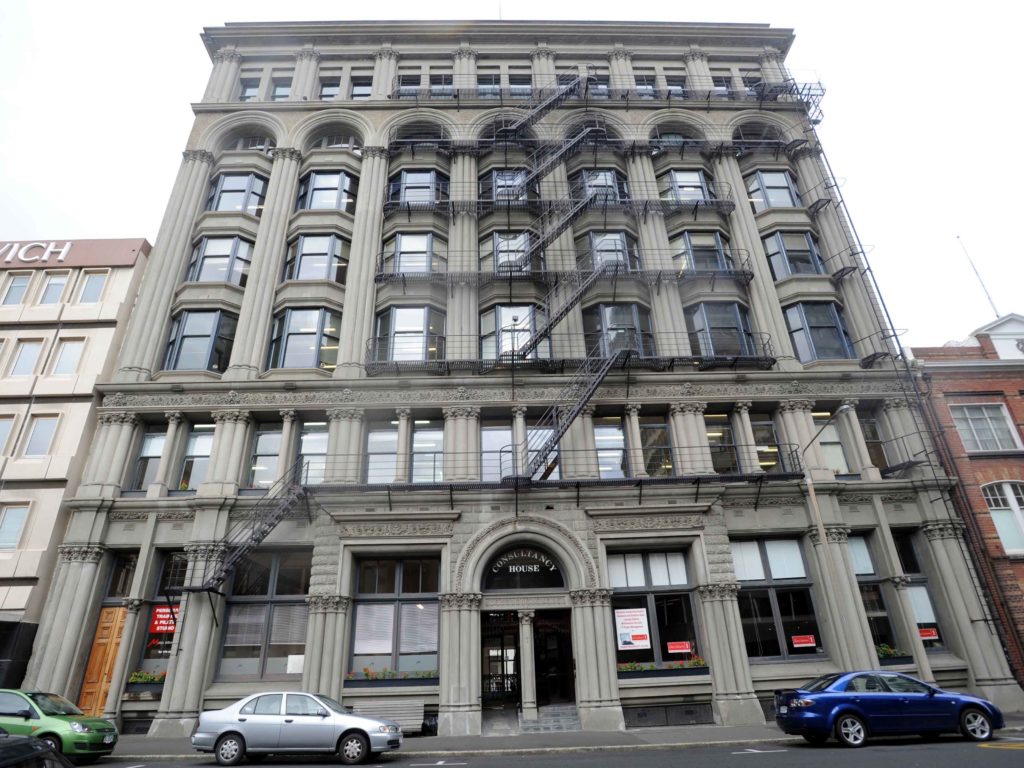In March 1889, Gustave Eiffel completed work on his famous tower in Paris. Just 8 months later, Dunedin was home to New Zealand’s wooden replica Eiffel Tower. It was in fact, one of the attractions at the city’s first South Seas Exhibition which ran through 1889 and 1890.
In the 19th Century, elevators were a new and exciting invention as multi storied buildings began to appear in various cities. The Astral Otis Elevator Company who built the elevators for the Paris tower was given the opportunity to display its technology in New Zealand when a 4 level replica Eiffel Tower was erected as a feature at the Dunedin show.
DUNEDIN’S TOWER
The Dunedin tower was built of wood and rose 40 metres (131 feet). This was 300m shorter than the tower in Paris. The elevator in its centre rose 30 metres (98 feet). The construction cost an amazing $226,000 in today’s money. To experience the thrilling elevator ride adults paid sixpence ($4.60 in today’s money) A steam engine hoisted the elevator on 4 wire cables and allowed it to stop on each of the 4 landings in the tower. One landing had a bar. Visitors could climb some steps from the top landing to reach the observation deck at the highest point of the tower. From there, they could survey the 5 hectares of the exhibition which housed a variety of gardens and halls as well as a 3000 seat concert venue and 6 art galleries. The elevator could accommodate 16 adults and was lit by electricity, another awesome innovation at the time. On Christmas Day and Boxing Day 1889, 3000 people took a ride in the elevator. At night, the tower was lit with powerful spotlights and it could be seen from many vantage points around the northern parts of the city.

SECOND TOWER AT THE EXHIBITION
There were actually two Eiffel Towers at the Dunedin exhibition. The second one stood 6 metres (19 feet) and was funded by Auckland whisky importer, King Walker and Company to promote its product. It has remained unclear what the connection was between a French landmark and Scottish whisky. It didn’t create the interest generated by the larger tower.
When the exhibition closed in April 1890, the tower was put up for auction with a reserve of just 30 pounds but it failed to sell. It was eventually sold for 32 pounds to a local resident without the elevator. It then faded into history.
NEW ZEALAND’S FIRST SKY SCRAPER
Elevators, more commonly called ‘lifts’ in New Zealand were also a talking point in New Zealand’s first ‘sky scraper’. During the first two decades of the 20th century, Dunedin was a New Zealand powerhouse for industry and commerce. Many of the country’s most influential companies had their head offices there and the substantial population at the time made it one of the biggest cities too. A number of these large companies built impressive buildings to show off their head offices. The NZ Express Company (a nationwide cartage business) was determined to stand out and in 1908, built the tallest building in New Zealand. At 8 stories (one underground) it is known as the country’s first ‘sky scraper’.

I have been in this building on a number of occasions and still remember the impressive lifts that travelled silently and quickly between the floors. These spacious lifts were one of the talked about features of this ‘skyscraper’. The building was one of the first in NZ to be built of precast concrete slabs. Right from the time it opened it has been a very popular building with it quickly filling up with tenants. The flat roof was another unique feature and became a promenade for tenants to use for eating lunch and surveying the city surrounding them. At one stage the building housed the Dunedin Stock Exchange along with professionals from lawyers to accountants and company managers. Today, re-named Consultancy House, it is still a popular building and is almost fully tenanted. I guess the lifts have continued to be a highlight of this impressive Dunedin ‘sky scraper’. A number of ugly multi storied buildings appeared in the vicinity in the 1960s, but they have only focused interest on the timeless design that went into the Chicago inspired NZ Express Company Building over a century ago.
Please leave a comment so I know how I’m doing with these blogs.
Ceidrik Heward
Ceidrik Heward is an Amazon TOP SELLING AUTHOR and has lived and worked in 7 countries working as a TV cameraman, director and film tutor. For the past 17 years he has focused on writing and has been published in magazines and newspapers in Europe, USA, Asia and the Middle East.
His interests include photography, psychology and metaphysics. He loves to read and always has at least 3 books on the go. He has written 22 manuals/books and has just completed his 4th short novel. Ceidrik believes sharing information and stories is the best way to stimulate the imagination and enrich our lives.




















 Visit Today : 413
Visit Today : 413 Total Visit : 1133590
Total Visit : 1133590
Speak Your Mind